Related Research Articles

Osaka is a designated city in the Kansai region of Honshu in Japan, and one of the three major cities of Japan (Tokyo-Osaka-Nagoya). It is the capital of and most populous city in Osaka Prefecture, and the third-most populous city in Japan, following the special wards of Tokyo and Yokohama. With a population of 2.7 million in the 2020 census, it is also the largest component of the Keihanshin Metropolitan Area, which is the second-largest metropolitan area in Japan and the 10th-largest urban area in the world with more than 19 million inhabitants.

Kawaii(Japanese: かわいい or 可愛い, IPA:[kawaiꜜi]; 'lovely', 'loveable', 'cute', or 'adorable') is the culture of cuteness in Japan. It can refer to items, humans, and non-humans that are charming, vulnerable, shy, and childlike. Examples include cute handwriting; certain genres of manga and anime; and characters such as Hello Kitty, as well as Pikachu from Pokémon.

Shinagawa is a special ward in the Tokyo Metropolis in Japan. The Ward refers to itself as Shinagawa City in English. The Ward is home to ten embassies.
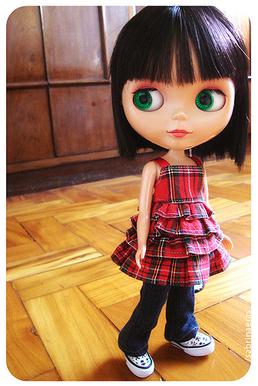
Blythe is a fashion doll, about 28 cm (11 inch) tall, with an oversized head and large eyes that change color with the pull of a string. It was created in 1972 and was initially only sold for one year in the United States by toy company Kenner. In 2001, the Japanese toy company Takara began producing new editions of Blythe dolls. There is a network of hobbyists who customize the doll for resale and create clothing and shoes for Blythe. Enthusiasts share photographs of their work and other types of dolls on the Internet.

Super Dollfie, often abbreviated SD, is a brand of ball-jointed doll, or BJD, made by the Japanese company Volks. They are made to be easy to customize and are primarily marketed to adult doll collectors and customizers. They are cast in polyurethane resin, a porcelain-like, hard, dense plastic. The most common standard models are about 60 cm, or 24 inches, tall, taller and heavier than most comparable Western dolls. They are designed in a style which is both realistic and influenced by anime, and most models are anatomically correct. The various body parts have ball joints for articulation, and are strung together with a thick elastic cord.
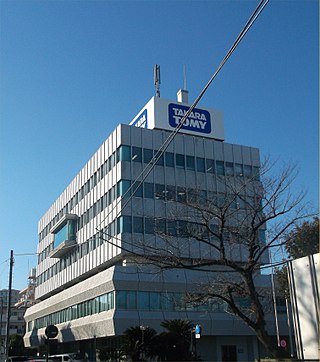
Takara Co., Ltd. was a Japanese toy company founded in 1955. In March 2006, the company merged with Tomy Company, Ltd. to form Takara Tomy. The Takara motto was「遊びは文化」("playing is culture").
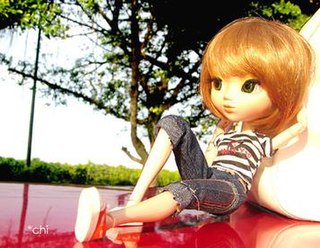
Pullip is a fashion doll created by Cheonsang Cheonha of South Korea in 2003. Pullip has a jointed plastic body and a relatively oversized head, with eyes that can move from side to side and eyelids that can blink. Pullip was first marketed by Jun Planning out of Japan; but the company underwent management changes in early 2009 and, since then, has operated out of South Korea under the name Groove. Since the release of the original female doll, other companion dolls have been added: male dolls Namu and Taeyang ; Taeyang's younger sister, Dal ; Dal's best friend, Byul ; and Pullip's younger brother, Isul. In February 2013, a new member of the Pullip family was introduced, called Yeolume, who is Pullip's future daughter. There is also a miniature line called Little Pullip, with 1:12 scale bodies and 1:6 scale heads. Pullip and her counterpart dolls are often customized by collectors, with the most common customizations including wig changes, eye color changes and rebodying.

The Harajuku Girls are four Japanese and Japanese-American backup dancers featured in stage shows and music videos for Gwen Stefani during her solo pop/dance-record career. The women also act as an entourage at Stefani's public appearances.

Tomy Company, Ltd., trading as Takara Tomy in Asia and Tomy elsewhere, is a Japanese toy company. It was established in 1924 by Eiichirō Tomiyama as Tomiyama Toy Manufacturing Company (富山玩具製作所), became known for creating popular toys like the B-29 friction toy and luck-based game Pop-up Pirate. In 2006, Tomy merged with another toy manufacturer, Takara, and although the English company name remained the same, it became Takara Tomy in Asia. It has its headquarters in Katsushika, Tokyo.

Fashion dolls are dolls primarily designed to be dressed to reflect fashion trends. They are manufactured both as toys for children to play with and as collectibles for adults. The dolls are usually modeled after teen girls or adult women, though child, male, and even some non-human variants exist. Contemporary fashion dolls are typically made of vinyl or another plastic.
Momoko Doll (モモコドール) is a 1/6 scale Japanese fashion doll, roughly similar in size to Robert Tonner's Tiny Kitty Collier.

Licca-chan is a Japanese fashion doll launched on July 4, 1967 by Takara, enjoying the same kind of popularity in Japan as the Barbie series does in the United States. Takara had sold over 48 million Licca-chan dolls as of 2002, and over 53 million as of 2007. Licca-chan was created by former shōjo manga artist, Miyako Maki.
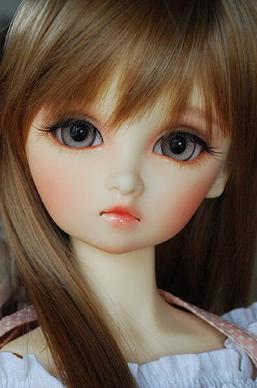
A ball-jointed doll is any doll that is articulated with ball and socket joints. In contemporary usage when referring to modern dolls, and particularly when using the acronyms BJD or ABJD, it usually refers to modern Asian ball-jointed dolls. These are cast in polyurethane synthetic resin, a hard, dense plastic, and the parts strung together with a thick elastic. They are predominantly produced in Japan, South Korea and China. The BJD style has been described as both realistic and influenced by anime. They commonly range in size from about 60 centimetres (24 in) for the larger dolls, 40 cm (15.5 in) for the mini dolls, and down to 10 cm (4 in) for the very smallest BJDs. BJDs are primarily intended for adult collectors and customizers. They are made to be easy to customize, by painting, changing the eyes and wig, and so forth.
China Dolls are a pop duo from Thailand. The group is composed of Pailin "Hwa Hwa" Rattanasangsatian and Supachaya "Bell" Lattisophonkul.
Jenny is a 10½ inch fashion doll produced by Takara since 1982. The doll was known as Takara Barbie, and in 1986 the doll was renamed "Jenny" after Takara ended their licensing agreement with Mattel. Takara Barbie differs from a western Barbie. Takara Barbie was altered to better appeal to Japanese preferences, with a shorter height, large rounded manga-style eyes and a closed mouth. Like her Western counterpart, Jenny wears a large variety of outfits, which often include street fashion, school uniforms, kimono, and other uniquely Japanese costumes, such as "Bullet-Train Stewardess Jenny". Today the Jenny doll is a sentimental favorite doll in Japan, but she is much less popular than Licca-chan, Japan's market leader fashion doll.

The Sybarite is a 16-inch resin or vinyl artist-doll designed by London artists Desmond Lingard and Charles Fegen in 2005. These dolls are largely produced in China, with occasional One of a Kind dolls made in London. Sybarite dolls are fully articulated mannequin-like dolls and have appeared in several fashion trades. HauteDoll features Sybarites on the Covers of their magazines.

Expert Show is Taiwanese Mandopop artist Show Lo's second Mandarin studio album. It was released on 22 October 2004 by Avex Taiwan. A second collectible edition, Expert Show (CD+VCD) was released on 25 November 2004 with a bonus VCD containing four music videos.
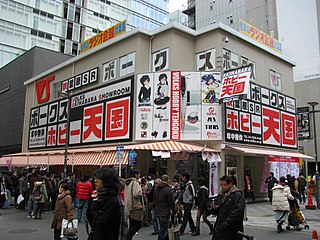
Volks, Inc. (ボークス) is a Japan-based corporation that produces garage kits and mecha kits as well as the Dollfie, Super Dollfie and Dollfie Dream lines of dolls. The company's headquarters is in Kyoto, with some 30 shops worldwide, and annual sales of about $50 million as of 2008.
Miyako Maki is a Japanese manga artist, and one of the earliest female manga artists. During the 1960s, Maki contributed significantly to the development of shōjo manga, and became one of the most popular shōjo authors of her generation. She later became a pioneer in manga for adults, producing gekiga and redikomi towards the end of that decade.
Gainax Co., Ltd. is a Japanese anime studio famous for productions such as Neon Genesis Evangelion, Royal Space Force, Gunbuster, Nadia: The Secret of Blue Water, Kare Kano, FLCL, Magical Shopping Arcade Abenobashi, and Gurren Lagann, which have garnered critical acclaim and commercial success. Evangelion has reportedly grossed over ¥150 billion, or approximately US$1.2 billion. In a discussion at the 2006 Tekkoshocon, Matt Greenfield claimed that Evangelion had grossed over US$2 billion; Takeda reiterated in 2002 that "It sold record numbers of laserdiscs in Japan, and the DVD is still selling well today", as well as for their association with award-winning anime director and studio co-founder Hideaki Anno. The company is headquartered in Koganei, Tokyo.
References
- ↑ Fashion Doll Quarterly 2005 article on Momoko Doll Archived January 27, 2007, at the Wayback Machine
- ↑ Fashion Doll Quarterly 2005 article "First Annual Dollstyle Convention" (in Tokyo)
- ↑ Momoko Doll lineup
- ↑ Pullip lineup Archived March 22, 2007, at the Wayback Machine
- ↑ Fashion Doll Quarterly article on Jenny Archived January 27, 2007, at the Wayback Machine
- ↑ "中国娃娃"可儿娃娃" 8月7日浪漫庆生_可乐生活数字报刊". Archived from the original on 2011-07-24. Retrieved 2009-07-14.
- ↑ https://licca.takaratomy.co.jp/official/whoislicca